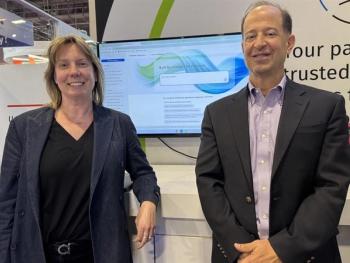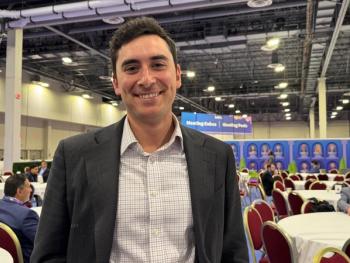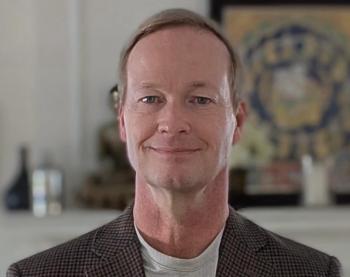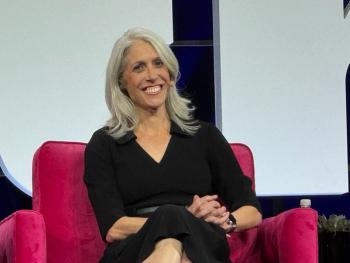
Tech Requires Design Thinking to Improve UX & Care
Geeta Nayyar, M.D., MBA: So health technology has gotten a lot of heat for causing physician burnout, right? It’s the EMR [electronic medical record], that’s the reason that all these doctors are burned out. I think doctors have been burned out for a long time, long before the EMR. But what is your take on it? What do you feel about that?
Janae Sharp: I think that’s a good thing. So we’ve been tracking, I’ve been tracking, news about burnout and about physician mental health for a while. And recently, there’s this huge surge of blaming your electronic health records. And at first, I was super frustrated. I thought, “Really, it’s not really your records. That’s not the problem.”
Geeta Nayyar, M.D., MBA: Well, it’s easier to blame the record, right?
Janae Sharp: Yes, and I think that can be a proxy measure for increased burden, but they’re also not that great. And that’s something that’s relatively modern, just saying that technology is the reason, technology is the failure. I called 2018 the year of hating your electronic health record [EHR]. That’s the theme of the year in the news. This is why we have all these problems. And so I don’t think that is everything. It’s been happening for a while, like you said.
Rasu Shrestha, M.D., MBA: It’s not everything, but I think it is something. It is something significant. We’ve got to call a spade a spade. And when you look at the specific tasks that physicians have across the board, we’re spending 44 percent of our time, on average, with our backs to the patients, entering notes into the EMR. We’re coders, we’re billers, we’re documenters. We’re not physicians 44 percent of the time, but that was not why I went into medical school.
Geeta Nayyar, M.D., MBA: It wasn’t for data entry?
Rasu Shrestha, M.D., MBA: No, it wasn’t for data entry. We didn’t go to medical school to enter notes into the EMR. Now, that’s part of how we practice the business of healthcare. That is absolutely all right, and there’s nothing wrong with that. But I do think that technology has become an impediment to care. So we need to call a spade a spade and address the notion that 44 percent of the time, I have my back faced to the patient.
Janae Sharp: Right.
Heather Staples Lavoie: What we found in our surveying is that a lot of physicians say the business and regulation of healthcare has actually caused a lot of the burden as well. We’re measuring people who are high performers and we’re expecting more and more from them. We’re reimbursing on an individual unit less and less. Primary care contributes so much to the overall health of a population, and yet they bear a disproportionate burden of all the documentation associated with care as well. And reimbursement being as it is and the requirement for documentation to be able to get credit for the service has placed an additional burden. So the EHR is the record keeping center of all of that, but all of that pressure has been placed on the back of the physicians.
Geeta Nayyar, M.D., MBA: I’m going to push back a little bit. So, when we rolled out the EMR at George Washington University, which is when I was in my training, everyone had a different user experience. I actually did not turn my back to the patient, Rasu. I just turned to the side and I would type like this, because I was able to do that. So every user is different. Specifically, from Heather’s point of view, how do you get your technologies to be adopted by physicians? Because to your point, a lot of doctors struggle with it, but if you’ve done it right, the idea was that data entry would be easier.
Rasu Shrestha, M.D., MBA: Well, there are workarounds, and I think the method that you described is one that’s been adopted by a lot of physicians as well. And that’s, in my opinion, a workaround, it’s a compromise. It is not the ideal state, and it would still contribute to burnout.
Geeta Nayyar, M.D., MBA: Well, it’s like a side-around.
Rasu Shrestha, M.D., MBA: Yes. One specific thing just to build on what Heather mentioned earlier is the notion of where we are as an industry. I think as an industry we’ve gotten to a point where healthcare is so darn complex. The order of the day in healthcare is really around defensive medicine. Defensive medicine is the reality of how healthcare functions today. Because of defensive medicine, what we’re mandated to do is to overdocument — copy/paste and copy/forward — and we’re putting in all sorts of codes. And everything is to cover my behind, so that I’m not going to get sued for the thing that I’m documenting or that the health system suddenly doesn’t lose all of this money as a result of a big lawsuit and all of that. And I think it’s important for us to diagnose ourselves as a healthcare industry and say, “All right, how did we get to this point? How do we really address the notion of this defensive medicine reality that is propagating the notion for us to document and for us to focus inordinately on these regulations that have become the reality of healthcare as we know it today?”
Janae Sharp: I think one of the things that’s important, too, is if you step back, maybe they weren’t taking good notes before health records. They weren’t doing a great job.
Geeta Nayyar, M.D., MBA: You couldn’t even read them.
Janae Sharp: Yes, they weren’t legible. So you’re adding something new to their job. They didn’t record what was happening before. So adding something new is more work. It’s better than nothing.
Geeta Nayyar, M.D., MBA: Well, I think that’s the opportunity, right? How do the health-tech vendors, how does a company like Geneia, fit in and actually make a difference? Perhaps we’re creating new problems, but at the same time, we’re certainly solving some of the old ones.
Heather Staples Lavoie: Well, I think there’s a certain degree of burden that can be lifted off physicians by spreading it across the care team. There’s a lot that can be done across a care team. The physician can be the quarterback, but there are a lot of other team members who can be thinking about pre-visit planning. They can actually be looking at documentation. They can be using analytic systems to see where there are gaps in care, where there are gaps in coding, and filling those in on behalf of the physician, so that the physician doesn’t have to do that when they’re at the most valuable point of their day, with the patient. There’s afterwork that can be done. There are certainly recorders, scribes who have been in offices. When I started out over 30 years ago in healthcare, I was a transcriptionist. And so I could do a darn good history and physical exam in my head now because I typed them up so often.
Geeta Nayyar, M.D., MBA: You’re hired.
Heather Staples Lavoie: I could type hepatosplenomegaly. But, in all honesty, there were other people who could do that on behalf of physicians, and we’ve gotten rid of transcription services that physicians relied on to do that afterwork documentation that was necessary, such that they could really meet with the patient. More of that could be done. There are other creative ways of doing that without necessarily having to involve the physician.
This is where we’ve made a call out to other health IT [information technology] companies, which is to involve the physician in the design: design of the process, design of the system. What’s going to work with them? And involve the patient: What’s going to work for the patient? Because, ultimately, physicians go into practice because they want to heal, they want to treat patients. That’s what they’re looking for, and so preserving that relationship is the most important thing. And so from both of their perspectives, ask what’s going to work and how can we modify systems around them, so that we can empower them.
Rasu Shrestha, M.D., MBA: I completely agree with you, and I’m agreeing also with what you mentioned earlier, Janae, that the EMR isn’t completely to be blamed for this. Given the fact that we have clinical information systems today that allow for us to share these massive troves of data across multiple geographies, multiple clinicians and collaborators — there are so many advantages to digital information systems. But it really does go back to what you mentioned earlier. The design of those solutions was done wrong.
Design thinking was not what we did in creating the solutions that we have today. We did not engage end users. The first time we engage physicians with that EMR solution that they’re going to be using on a day-in/day-out basis is after that RFP [request for proposal] process is done, after we go live with the solution. And then we have this training and we buy them pizza and we give them a cheat sheet, and we say, “Hey, good luck with it.”
Oh my goodness, that is not the way to engage in the process of designing this solution. So the process of design thinking entails the end users — the clinicians, the patients as you rightly said — being involved in the very co-creation of these solutions before a single line of code is ever written, to make sure that they’re consistently involved in the iterative processes of design thinking. So it’s really important to make sure we get them in early, often, and consistently.
Geeta Nayyar, M.D., MBA: I couldn’t agree with you more, Rasu. I don’t think we were doing design thinking. I don’t even think we were thinking, right?
Rasu Shrestha, M.D., MBA: That’s right.
Geeta Nayyar, M.D., MBA: We were creating systems that doctors were really just hired to sell. They were never part of the process, and I think clearly all of you are agreeing that this needs to be done with physicians for physicians as opposed to without.
Janae Sharp: I think too, if you look at it, we moved from a 3x5 inch card to a giant electronic record that has a lot more 3x5 cards involved in it. And we’re not utilizing technology to do what technology is good at….
Geeta Nayyar, M.D., MBA: We’re replicating the 3x5 cards.
Janae Sharp: We’re creating the 3x5 card, and that’s something that can help us find a huge opportunity. And design thinking is something in creation now that’s popular, and I really like that. What we have is better than the 3x5 card, but technology can process images, like you said, so much faster. It can become a tool for physicians to use rather than just your free time at home, which right now, it’s like your hobby after work. But it could actually help you at the point of care.
Reduce Physician Burnout








































